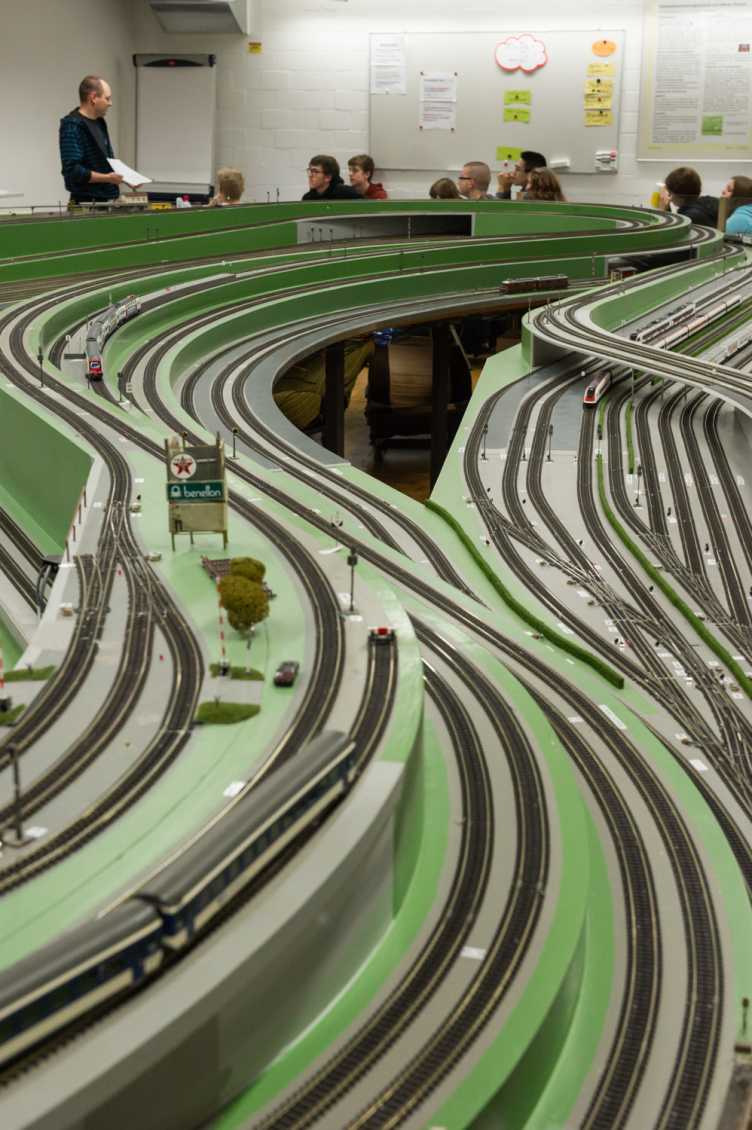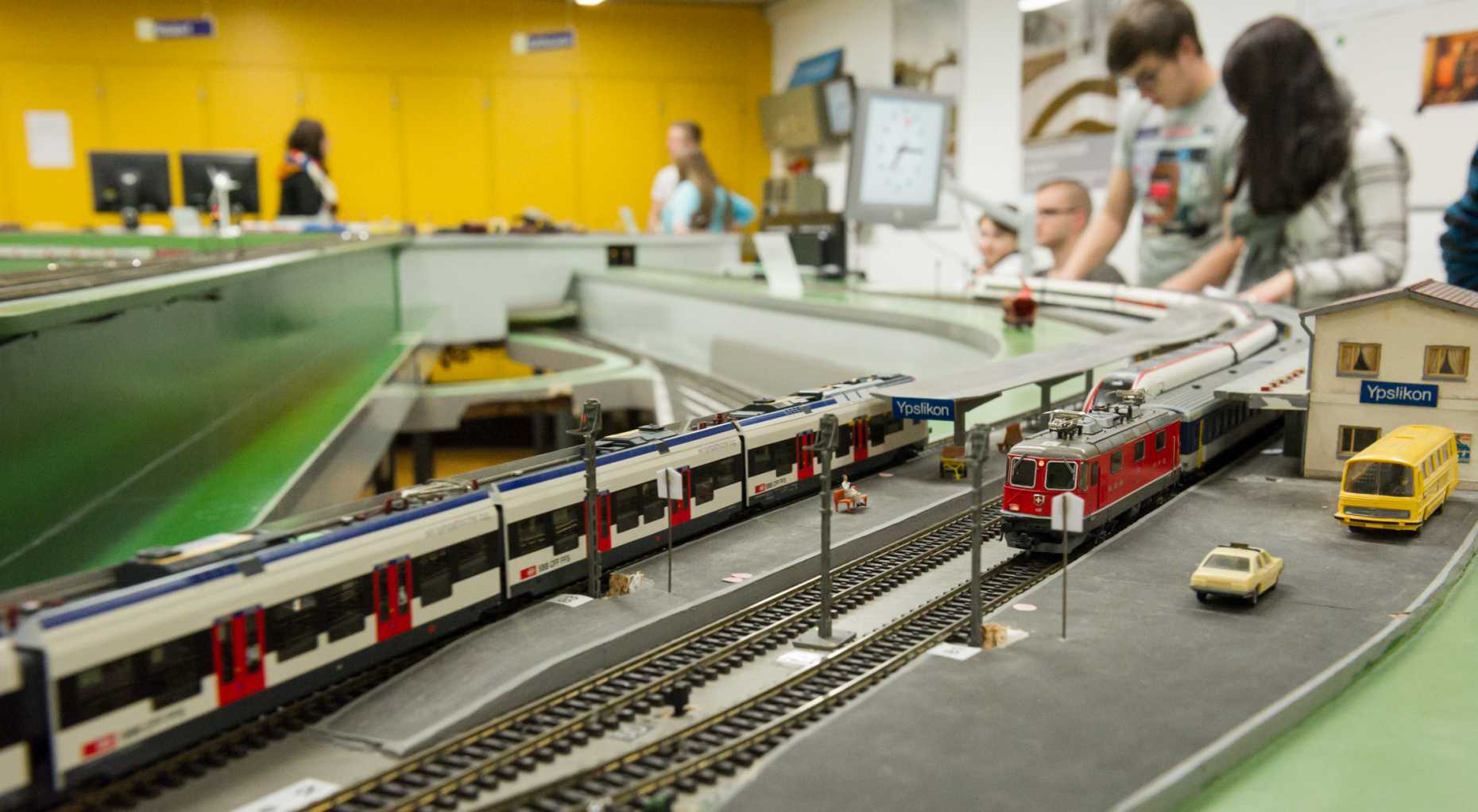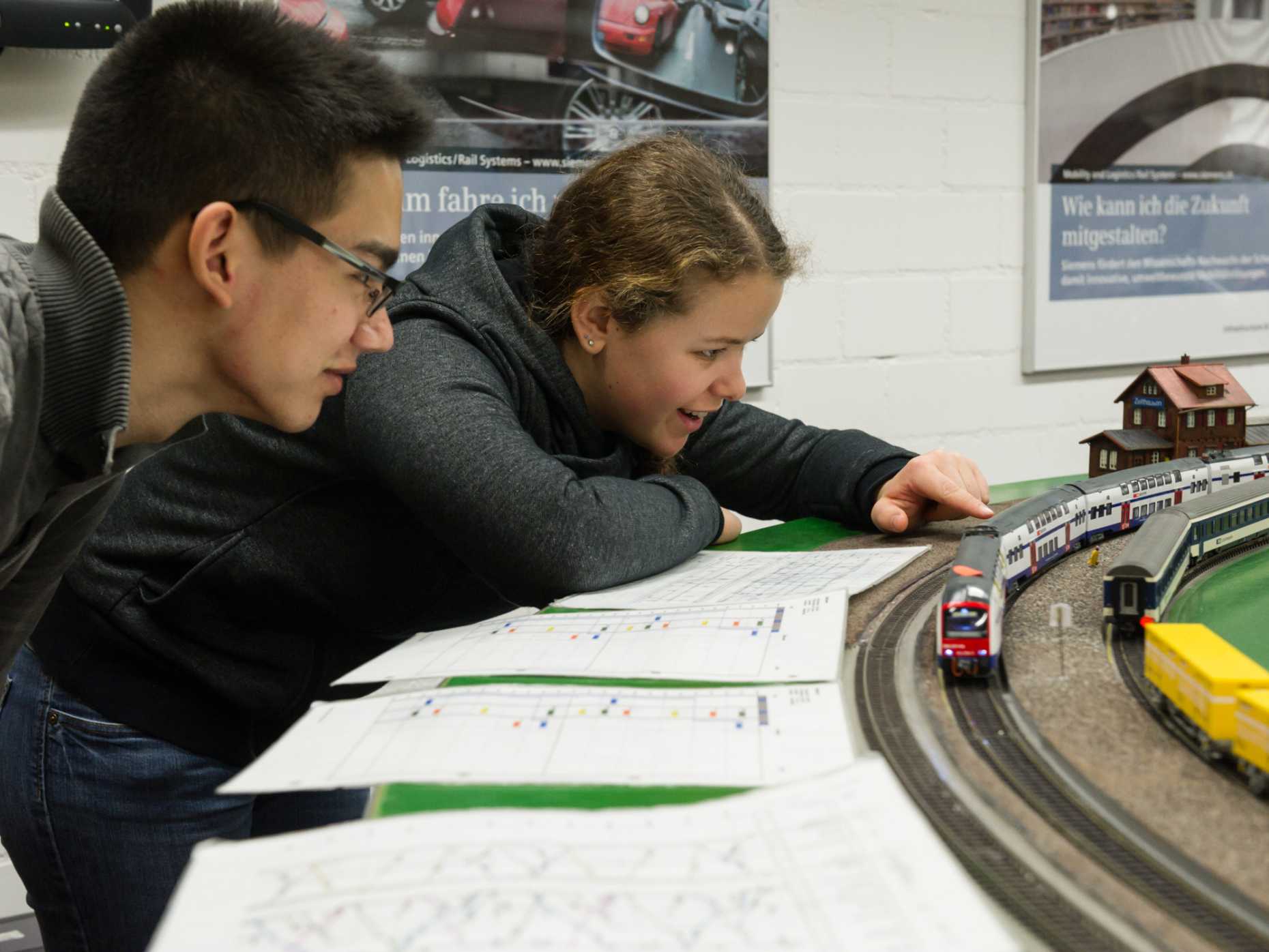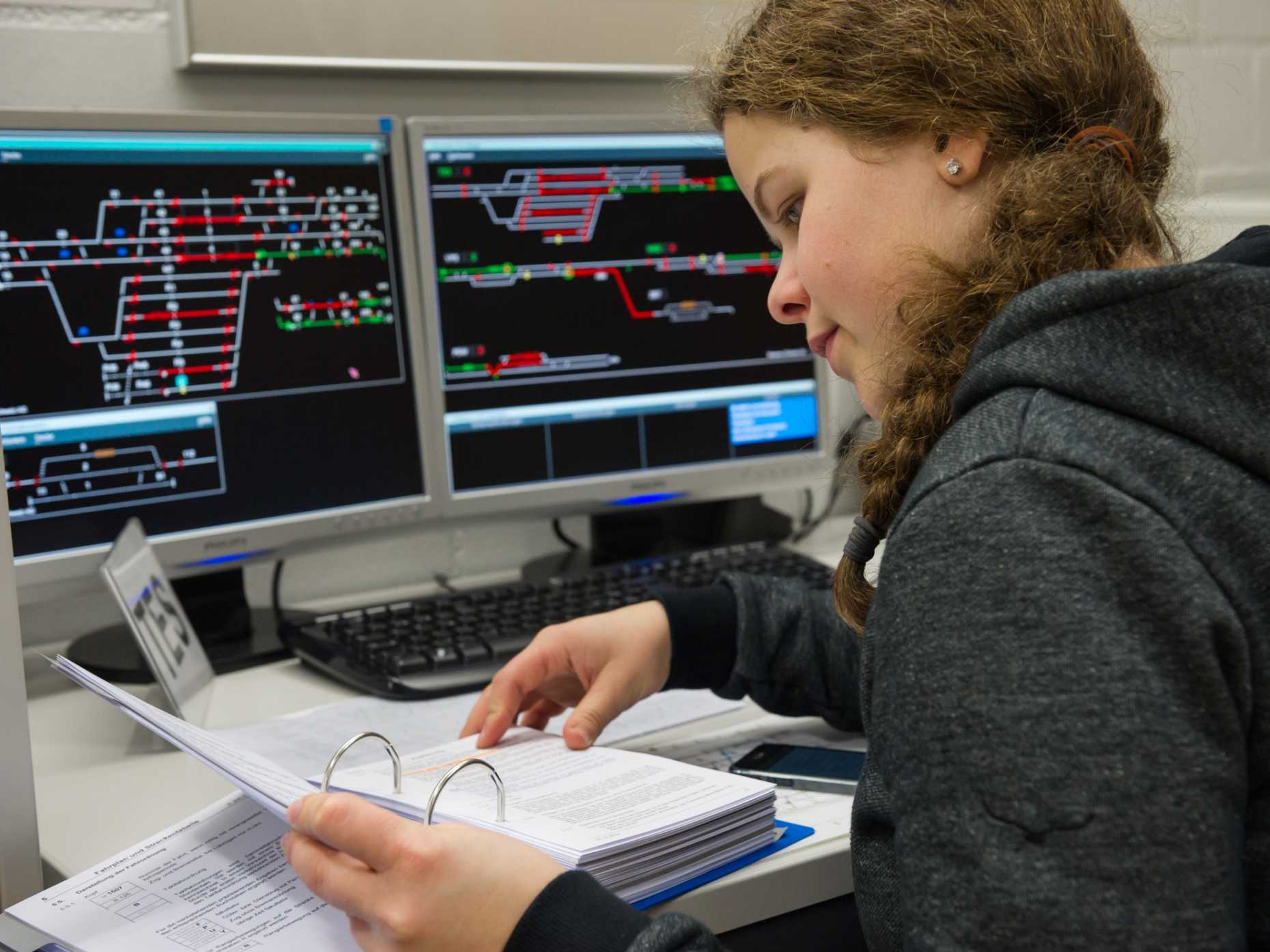Full steam ahead
A training centre, not a games room: students and SBB trainees alike learn their trade in the ETH railway operations laboratory.
Michael Fürer welcomes his class: “I’m delighted that you’re all on time – despite the driving snow.” And he should know. In his job, the rail traffic controller has seen first-hand how the weather can bring public transport to a standstill. He works in the signalling centre in the Zurich district of Oerlikon, where he directs trains to Effretikon or Niederglatt three days a week. The rest of the time he spends training budding rail traffic controllers. Today he has brought his class to ETH Zurich’s Hönggerberg campus, where there is a railway operations laboratory in the building that houses the Institute for Transport Planning and Systems. Despite its location in a basement room with no natural light, the laboratory is still guaranteed to set any railway enthusiast’s pulse racing.
More than half a kilometre of track winds its way around the model railway. Space enough for Jonas Bühler, Manuela Marty and the other eight trainees to let off steam, practise and play out various scenarios from their everyday work. The aim of today’s visit to ETH Zurich is to cement their background knowledge and practise normal operations. Dealing with faults will come later. “That would be overshooting the mark”, says Michael Fürer. This is only his fourth visit to the railway operations laboratory with his class. The model railway belongs to ETH Zurich, but the university shares responsibility for its upkeep with SBB and Siemens.
Manuela and Jonas like to visit the railway operations laboratory. “Unfortunately, it’s a bit dull at school”, comments Manuela. Jonas adds: “And in our day-to-day work we aren’t allowed to do anything by ourselves yet.” But here they can work the levers, switches and buttons themselves – and make mistakes. “This is where the mistakes have to be made that can’t happen at work. That’s how they learn the most”, says their instructor Fürer. “I would only be unhappy if they were to keep repeating the same mistakes.”
Overall, he is very patient with his students because they are still absolute beginners. They are currently in their third year of training as public transport managers specialising in the railways. Since last summer they have been enjoying their first contact with their future occupation as rail traffic controllers. As they have selected this option in their third and final year of training, the additional instruction for rail traffic controllers will be reduced from eight to six months – if they decide to go for it, that is. Manuela und Jonas did not have to think about it for very long. They are both sure that they will sign up for the six months after completing their training. “I like the technical side of the job”, says Manuela as she turns the switch to set the points. “I wouldn’t want to spend the whole day in front of a computer screen writing letters.”
Not a computer game

Manuela works for the Rhätische Bahn at Landquart station, Jonas in the SBB Operations Control Centre East located at Zurich Airport. But today they are both in Zetthausen for a timetable simulation. Zetthausen is a fictional station in the model system and has the second oldest signal box, dating back to the 1940s. While operating a signal box like this one will not be part of their future duties, a few stations in Switzerland still have these electromechanical signal boxes. Most of the routes today have ultra-modern control systems; everything is done electronically by computer. In the past, the railway service manager had to use all his strength to move the large lever to control the cables and set the points outside, but today, points, barriers and signals are controlled with just a few clicks of the mouse. This is why the training sessions at ETH Zurich always focus on helping the trainees develop a feeling for what is happening outside when they are in front of the computer. “Every red line on the screen is a train with passengers”, stresses Fürer. “This is not a computer game.” The model allows the trainees to see the direct results of their actions. Not only do the drive mechanisms make a noise – you can also hear the relay switches click-clacking in the next room. The model railway promotes an awareness of participants’ radius of action.
At Operations Control Centre East at the airport, Jonas watches planes taking off every ten minutes but does not see the trains arriving and departing. Even Zurich’s main railway station has been controlled from the airport since May of last year. In a few years there will be only four SBB Operations Control Centres left: at Zurich airport, and in Lausanne, Olten and Pollegia. This development is likely to break the heart of many an old stationmaster who once directed trains on the platform with a signalling disk.
But the Zetthausen model railway is operated manually – by Manuela und Jonas. It is actually close to midday, but Fürer has set the large screen clocks, which you cannot miss hanging on the wall, to 5.55 a.m. A one-hour timetable simulation is scheduled to begin in five minutes. Fürer could also make the clocks run faster, but that is only in training sessions for advanced students. For the trainees, the normal speed is already fast enough. In one hour the six passenger and goods trains will be running a good 20 minutes late – at least, the ones which are still running at all.
But Fürer is right in his element and very happy. He sees every mishap and false move as an opportunity for the trainees to learn another important aspect – and never forget it. That is why he does not engage in a detailed round of evaluations in which every move is analysed afterwards. He much prefers to intervene in real time and gives Manuela and Jonas plenty of time to decide on the next steps. The fact that punctuality gets completely left behind is not important to him. Fürer succeeds in mastering the impressive balancing act between his two roles: today the understanding and patient teacher, tomorrow the conscientious and busy rail traffic controller.
A feeling for planning
Manuela and Jonas are needed. Fürer has contacted them by radio – which is still an important part of the job, even in the era of smartphones. A train is ending its journey unexpectedly in Zetthausen. Onto which one of the three tracks should it be shunted? The trainees practised this situation in the morning as one of four case studies. Fürer and the other two trainees played through various situations in small groups. Zetthausen is particularly tricky: as the station does not have an underpass, there is no ideal solution. Whenever there is a train at a platform, there is always the possibility that passengers may try to climb on board. In the absence of an underpass, dangerous situations can always arise when a train is shunted to a particular track and normal operations continue. “The model railway gives them a feeling for planning”, says Fürer. That is why the little figures in the model railway scene are not just a nice decoration for enthusiasts – they render the situation more lifelike and tangible. Ultimately, it all comes down to passenger and staff safety. Training is also about making the students aware of this responsibility. “As a rail traffic controller, there’s no margin for error”, says Fürer.
A thick folder with all the operating regulations ensures that everything goes smooth-ly on all the tracks. The Federal Office of Transport (FOT) regulations are on the white pages, and the SBB supplements are on the green ones. The trainees’ folders still look rather new – unlike the teacher’s copy. They are still cautiously looking up rules and symbols. Working with the file takes practice, which is why Fürer keeps telling them to “look in your folder” all day long. Spoon-feeding will not help his protégés at all. But Fürer, too, has to do his homework and make sure he knows the rules. “The trainees are an additional incentive for me to keep up to speed”, he says. “Working with students helps me stay young.”
Full of praise
The first simulation round is over. Fürer wants to know how his students fared. It quickly becomes obvious that there was some confusion – not because there was too little communication, but because there was too much. “You really must only communicate the essentials”, sums up Fürer. What is of interest to a construction worker, what to a train driver? These are the questions that rail traffic controllers must ask themselves.
Even if some things went wrong during the simulation, Fürer is full of praise in the ensuing feedback session. He describes mistakes as “wonderful situations in which you can learn a great deal”. He knows how to motivate his students. And they cannot wait to get their teeth into the next simulation.



Comments
No comments yet